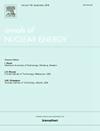A method fusing self-attention-SPN and NSGA-III for multi-objective radiation shielding design optimization
IF 1.9
3区 工程技术
Q1 NUCLEAR SCIENCE & TECHNOLOGY
引用次数: 0
Abstract
High-performance compact nuclear facilities require radiation shielding designs that balance safety and weight considerations. Current intelligent shielding design methods typically combine Evolutionary Algorithms (EA) for optimization with neural networks for evaluation. However, the neural networks used, primarily BP or DNN models composed of Fully Connected (FC) layers, require large datasets and extensive computation resources. A novel method fusing Self-Attention-based Sequence Prediction Network (Self-Attention-SPN) and Non-dominated Sorting Genetic Algorithm III (NSGA-III) was proposed in this paper for multi-objective radiation shielding design optimization. By reformulating dose rate calculation as a sequence prediction problem, the SPN of lightweight network structure leverages the multi-physics feature projection and multi-head self-attention mechanism to effectively capture the inter-layer physical feature relationships, ensuring high prediction accuracy with small datasets. The method is validated using the Savannah reactor case, where SPN achieves Monte Carlo (MC)-level accuracy with significantly reduced computational cost. Comparative experiments show that training data with additional physical parameters can reduce SPN training loss, underscoring the importance of physical information. Furthermore, SPN outperforms BP in prediction accuracy, validating the effectiveness of the multi-head self-attention mechanism. Sensitivity analysis of NSGA-III coupled with SPN prediction perturbation confirms the robustness of the proposed method. The optimization solutions effectively converge to the Pareto front, demonstrating the method’s efficiency and reliability for multi-objective radiation shielding design.
一种融合自关注- spn和NSGA-III的多目标辐射屏蔽设计优化方法
高性能紧凑型核设施需要兼顾安全和重量考虑的辐射屏蔽设计。目前的智能屏蔽设计方法主要是将进化算法(EA)优化与神经网络评估相结合。然而,所使用的神经网络,主要是由完全连接(FC)层组成的BP或DNN模型,需要大量的数据集和大量的计算资源。提出了一种融合基于自注意的序列预测网络(Self-Attention-SPN)和非支配排序遗传算法(NSGA-III)的多目标辐射屏蔽设计优化方法。轻量化网络结构SPN通过将剂量率计算重新表述为序列预测问题,利用多物理场特征投影和多头部自关注机制,有效捕获层间物理特征关系,保证了小数据集下的高预测精度。该方法在萨凡纳反应器案例中得到了验证,SPN在显著降低计算成本的情况下达到了蒙特卡罗(MC)级别的精度。对比实验表明,添加物理参数的训练数据可以减少SPN的训练损失,强调物理信息的重要性。此外,SPN在预测精度上优于BP,验证了多头自注意机制的有效性。NSGA-III耦合SPN预测扰动的敏感性分析证实了所提方法的鲁棒性。优化解有效收敛到Pareto前沿,证明了该方法在多目标辐射屏蔽设计中的有效性和可靠性。
本文章由计算机程序翻译,如有差异,请以英文原文为准。
求助全文
约1分钟内获得全文
求助全文
来源期刊

Annals of Nuclear Energy
工程技术-核科学技术
CiteScore
4.30
自引率
21.10%
发文量
632
审稿时长
7.3 months
期刊介绍:
Annals of Nuclear Energy provides an international medium for the communication of original research, ideas and developments in all areas of the field of nuclear energy science and technology. Its scope embraces nuclear fuel reserves, fuel cycles and cost, materials, processing, system and component technology (fission only), design and optimization, direct conversion of nuclear energy sources, environmental control, reactor physics, heat transfer and fluid dynamics, structural analysis, fuel management, future developments, nuclear fuel and safety, nuclear aerosol, neutron physics, computer technology (both software and hardware), risk assessment, radioactive waste disposal and reactor thermal hydraulics. Papers submitted to Annals need to demonstrate a clear link to nuclear power generation/nuclear engineering. Papers which deal with pure nuclear physics, pure health physics, imaging, or attenuation and shielding properties of concretes and various geological materials are not within the scope of the journal. Also, papers that deal with policy or economics are not within the scope of the journal.
 求助内容:
求助内容: 应助结果提醒方式:
应助结果提醒方式:


